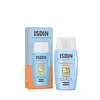What's inside
What's inside
 Key Ingredients
Key Ingredients

 Benefits
Benefits

 Concerns
Concerns

 Ingredients Side-by-side
Ingredients Side-by-side

Water
Skin ConditioningDibutyl Adipate
EmollientPropanediol
SolventEthylhexyl Salicylate
UV AbsorberEthylhexyl Triazone
UV AbsorberBis-Ethylhexyloxyphenol Methoxyphenyl Triazine
Skin ConditioningDimethicone
EmollientButyl Methoxydibenzoylmethane
UV AbsorberPhenylbenzimidazole Sulfonic Acid
UV AbsorberSilica
AbrasiveDiisopropyl Sebacate
EmollientArginine
MaskingPentylene Glycol
Skin ConditioningHydroxyacetophenone
AntioxidantLauryl PEG/PPG-18/18 Methicone
Skin ConditioningVp/Eicosene Copolymer
Polysorbate 60
EmulsifyingDimethicone/Vinyl Dimethicone Crosspolymer
Skin ConditioningGlycerin
HumectantCaprylyl Glycol
EmollientHydrated Silica
AbrasiveTocopheryl Acetate
AntioxidantPEG-10 Dimethicone
Skin ConditioningTetrasodium Glutamate Diacetate
Parfum
MaskingSclerotium Gum
Emulsion StabilisingSodium Hyaluronate
HumectantPorphyridium Cruentum Extract
Skin ConditioningXanthan Gum
EmulsifyingCitric Acid
BufferingWater, Dibutyl Adipate, Propanediol, Ethylhexyl Salicylate, Ethylhexyl Triazone, Bis-Ethylhexyloxyphenol Methoxyphenyl Triazine, Dimethicone, Butyl Methoxydibenzoylmethane, Phenylbenzimidazole Sulfonic Acid, Silica, Diisopropyl Sebacate, Arginine, Pentylene Glycol, Hydroxyacetophenone, Lauryl PEG/PPG-18/18 Methicone, Vp/Eicosene Copolymer, Polysorbate 60, Dimethicone/Vinyl Dimethicone Crosspolymer, Glycerin, Caprylyl Glycol, Hydrated Silica, Tocopheryl Acetate, PEG-10 Dimethicone, Tetrasodium Glutamate Diacetate, Parfum, Sclerotium Gum, Sodium Hyaluronate, Porphyridium Cruentum Extract, Xanthan Gum, Citric Acid
Titanium Dioxide 6.5%
Cosmetic ColorantZinc Oxide 18.7%
Cosmetic ColorantWater
Skin ConditioningIsohexadecane
EmollientC12-15 Alkyl Benzoate
AntimicrobialEthylhexyl Methoxycrylene
Skin ConditioningBehenyl Alcohol
EmollientSteareth-21
CleansingGlyceryl Stearate
EmollientPEG-100 Stearate
Calcium Aluminum Borosilicate
Euphorbia Cerifera Wax
Polyhydroxystearic Acid
EmulsifyingCetyl Alcohol
EmollientTriethoxycaprylylsilane
Aluminum Hydroxide
EmollientXanthan Gum
EmulsifyingStearic Acid
CleansingPhenoxyethanol
PreservativeEthylhexylglycerin
Skin ConditioningGlycerin
HumectantChlorphenesin
AntimicrobialTocopheryl Acetate
AntioxidantDisodium EDTA
Aloe Barbadensis Leaf Extract
EmollientAvena Sativa Kernel Extract
AbrasiveTitanium Dioxide 6.5%, Zinc Oxide 18.7%, Water, Isohexadecane, C12-15 Alkyl Benzoate, Ethylhexyl Methoxycrylene, Behenyl Alcohol, Steareth-21, Glyceryl Stearate, PEG-100 Stearate, Calcium Aluminum Borosilicate, Euphorbia Cerifera Wax, Polyhydroxystearic Acid, Cetyl Alcohol, Triethoxycaprylylsilane, Aluminum Hydroxide, Xanthan Gum, Stearic Acid, Phenoxyethanol, Ethylhexylglycerin, Glycerin, Chlorphenesin, Tocopheryl Acetate, Disodium EDTA, Aloe Barbadensis Leaf Extract, Avena Sativa Kernel Extract
 Reviews
Reviews

Ingredients Explained
These ingredients are found in both products.
Ingredients higher up in an ingredient list are typically present in a larger amount.
Glycerin is already naturally found in your skin. It helps moisturize and protect your skin.
A study from 2016 found glycerin to be more effective as a humectant than AHAs and hyaluronic acid.
As a humectant, it helps the skin stay hydrated by pulling moisture to your skin. The low molecular weight of glycerin allows it to pull moisture into the deeper layers of your skin.
Hydrated skin improves your skin barrier; Your skin barrier helps protect against irritants and bacteria.
Glycerin has also been found to have antimicrobial and antiviral properties. Due to these properties, glycerin is often used in wound and burn treatments.
In cosmetics, glycerin is usually derived from plants such as soybean or palm. However, it can also be sourced from animals, such as tallow or animal fat.
This ingredient is organic, colorless, odorless, and non-toxic.
Glycerin is the name for this ingredient in American English. British English uses Glycerol/Glycerine.
Learn more about GlycerinTocopheryl Acetate is AKA Vitamin E. It is an antioxidant and protects your skin from free radicals. Free radicals damage the skin by breaking down collagen.
One study found using Tocopheryl Acetate with Vitamin C decreased the number of sunburned cells.
Tocopheryl Acetate is commonly found in both skincare and dietary supplements.
Learn more about Tocopheryl AcetateWater. It's the most common cosmetic ingredient of all. You'll usually see it at the top of ingredient lists, meaning that it makes up the largest part of the product.
So why is it so popular? Water most often acts as a solvent - this means that it helps dissolve other ingredients into the formulation.
You'll also recognize water as that liquid we all need to stay alive. If you see this, drink a glass of water. Stay hydrated!
Learn more about WaterXanthan gum is used as a stabilizer and thickener within cosmetic products. It helps give products a sticky, thick feeling - preventing them from being too runny.
On the technical side of things, xanthan gum is a polysaccharide - a combination consisting of multiple sugar molecules bonded together.
Xanthan gum is a pretty common and great ingredient. It is a natural, non-toxic, non-irritating ingredient that is also commonly used in food products.
Learn more about Xanthan Gum